Venturing into parenthood often comes with many questions, especially regarding the health and nutrition of the baby. Decisions about feeding may seem inundated with advice from multiple quarters, bringing in an added layer of uncertainty. Among the plethora of queries, how to introduce water into a baby’s diet, specifically when using distilled water for formula preparation bears special significance. The type of water used, the safety measures involved to maintain its purity, and timing it right, are all critical aspects that modern parents strive to perfect in their journey of safe infancy diet.
In this blog post, we aim to unravel the intricacies surrounding the use of distilled water for baby formulas. We will shed more light on the distilled water itself, its advantages, and the considerations you should be taking into account when introducing it to your baby’s diet. Additionally, we promise to guide you with some tried and tested methods of ensuring a smooth transition for babies towards consuming water. Reading this blog will hopefully bring you a step closer in perpetuating healthier growth and development for your tiny bundle of joy.
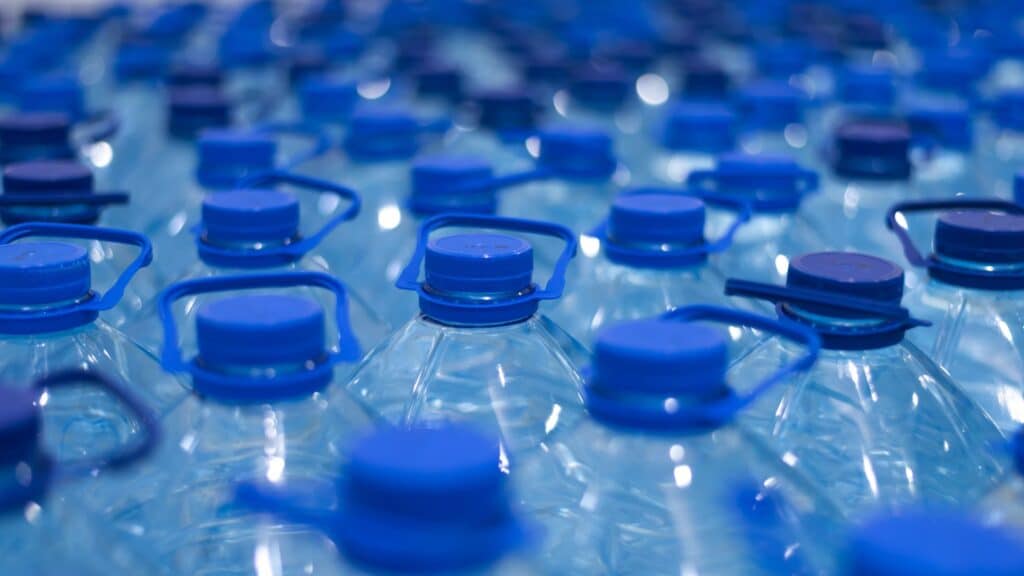
What is Distilled Water?
Distilled water is a type of water that has gone through a process of distillation, which involves boiling water and collecting the steam that is produced, which is then condensed back into a liquid.
This process removes impurities and minerals from the water, creating a highly purified product that is often used for laboratory experiments, medical procedures, and other specialized applications.
Distilled water is often recommended by the American Academy of Pediatrics for preparing infant formula, as it has been stripped of these harmful contaminants, making it a safe and consistent choice for preparing infant formula.
Additionally, distilled water can be a good option for parents who want to remove fluoride from their baby’s drinking water. By using distilled water, you can ensure that your baby is getting the cleanest and safest possible water to support their health and development.
Advantages of Using Distilled Water for Formula Feeding
There are several advantages to using distilled water for infant formula feeding:
Reduced risk of contaminants: Using distilled water for preparing mixed formula is one way to reduce the risk of contaminants in your baby’s feeding.
While tap water is generally safe to drink, it may contain harmful substances like fluoride or bacteria that can cause tooth disease or tooth decay in infants.
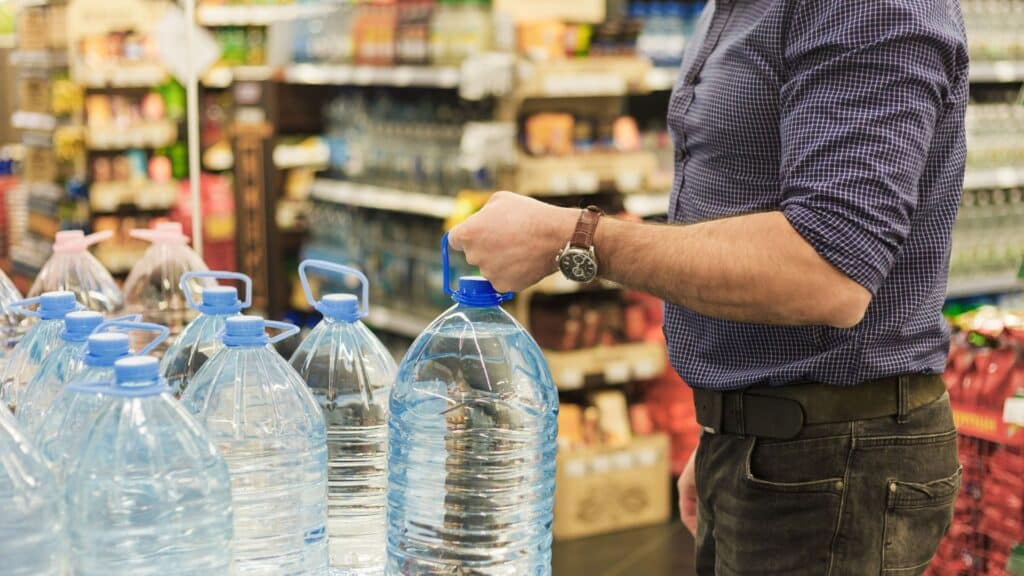
Consistent quality: Distilled water has a consistent quality, which means that the water you use to prepare your baby’s formula will have the same composition every time. This can help ensure that your baby is receiving the right balance of nutrients in their mix formula powder.
According to the Centers for Disease Control and Prevention (CDC), using consistent quality water for infant formula preparation is important for the health and safety of babies.
Easy to obtain: Distilled water is widely available at grocery stores and online, making it easy to obtain to prepare infant formula.
Less build-up in equipment: Using distilled water can help reduce mineral build-up in your baby’s bottled water and other feeding equipment. This can help prolong the life of the equipment and reduce the need for frequent cleaning and descaling.
Suitable for sensitive babies: Some babies may be sensitive to the minerals or chemicals in tap water, and using distilled water can help reduce the risk of adverse reactions.
The Centers for Disease Control and Prevention (CDC) recommends that families with babies who have weakened immune systems, are born prematurely, or are otherwise considered at risk should use distilled water when mixing infant formula. This is because some tap water sources may contain too much fluoride, which can lead to faint white lines or spots on a baby’s developing teeth, a condition called dental fluorosis.
To ensure that the optimal level of fluoride is maintained, water treatment plants closely monitor fluoride levels and adjust the concentration as needed. It’s worth noting that the benefits of fluoridated water, including the prevention of dental cavities, outweigh the potential risks associated with excessive consumption. However, families with infants at risk of dental fluorosis should follow the CDC’s recommendation and use distilled water when mixing formula.
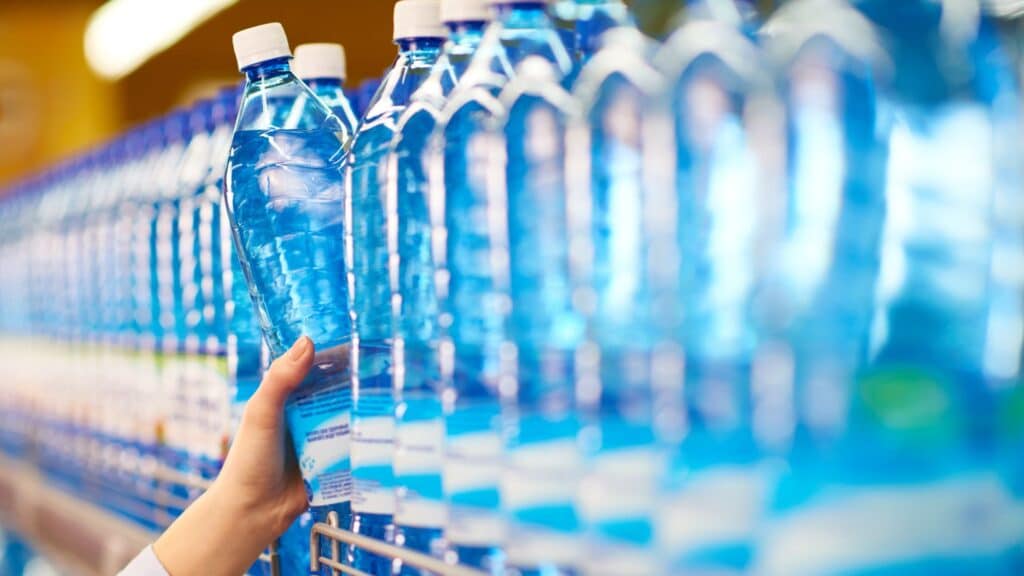
When to Introduce Water to a Baby’s Diet
Babies under six months old should not be given water, as they receive adequate hydration from breast milk or baby formula. When babies start eating solid foods, around six months of age, it’s safe to introduce small amounts of water in a cup or bottled water to help with digestion and hydration.
When mixing water for baby formula, it’s essential to use the proper ratio of water to the powder. It’s also essential to prepare formulas safely by using hot water that has been brought to a rolling boil or using cold water that has been chilled to body temperature, depending on the instructions on the powdered formula container.
By using the prepared formula method, parents can ensure that their baby’s formula is safe and nutritious.
The Best Ways to Introduce Water to a Baby’s Diet
If you’re concerned about your child not drinking enough water, try these tips to get them drinking for a healthier body and mind.
Gradual Introduction of Water
For the best and safest introduction of water to your baby’s diet, do it gradually. In the same way, you would introduce any new food or drink to your baby, start by giving them small amounts of water as part of their meals and snacks.
The Temperature of Water for Baby’s Comfort
Babies have sensitive taste buds. The best way to introduce water to their diet is at room temperature or warm water that is not overly cold or excessively hot. You can add herbs and citrus fruits to the water to subtly enhance its flavor and make the transition easier.
However, it’s important to note that when preparing water for a baby, maintaining safe water temperatures is essential to avoid any potential harm to your little one’s delicate system. Believe it or not, the temperature of water can greatly impact your baby’s acceptance of it. Providing them with room temperature or slightly warm water might feel more familiar to them as it similarizes with the breast milk or formula they are often fed with.
Consistent with the baby’s sensitivity to taste and temperature, avoid serving it straight from the fridge or directly after boiling. Extreme temperature changes can upset their digestive system. Furthermore, consider using a specially designed baby thermometer to ensure the water temperature stays within a comfortable range.
Remember, our aim is to encourage hydration without causing discomfort. Gradually, your baby will grow accustomed to drinking water at room temperature, which is important for their hydration habits in the long run. This aspect is yet another careful consideration when venturing through the exciting journey of parenthood.
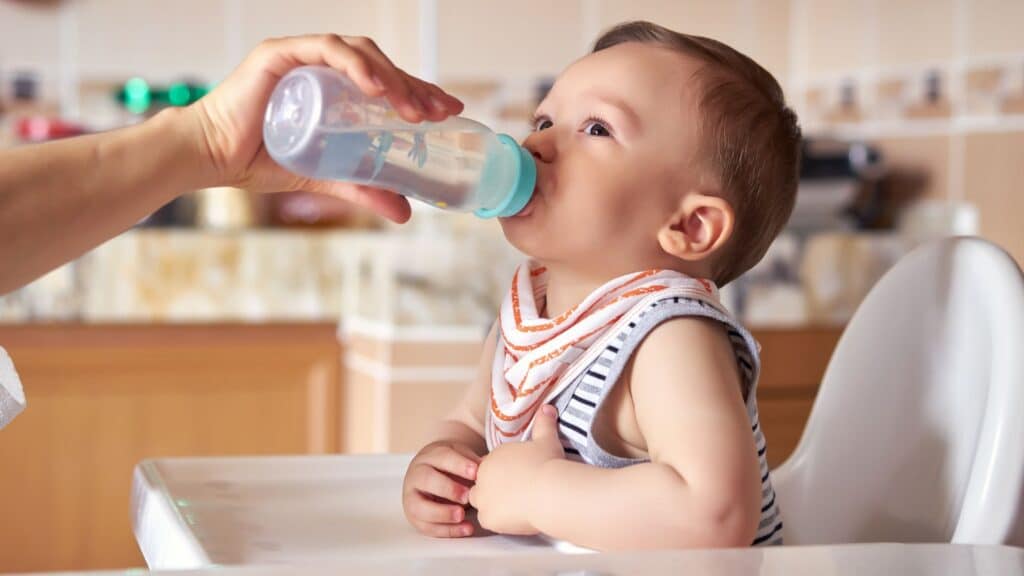
Offering Water Between Feedings
Introducing your baby to drinking water between feedings is a great way to help them get used to the sensation of swallowing. The first time you introduce water will vary from baby to baby, but oftentimes it’s when they’re around 6-8 months old or starting solids. You can start by offering them a bottle of water after feeding, before bedtime, or if they need relief from teething pain. It’s important to let your baby have time with their bottle before you offer them or another drink.
Using a Sippy Cup or Small Feeding Bottle
Use a small feeding bottle or sippy cup to introduce water to your baby’s diet. When you first begin giving your baby water, it’s best to use a sippy cup with a slow-flow spout, which limits the amount of liquid that enters the baby’s mouth at one time. Start by filling the cup 1/4 full and waiting for several minutes between feedings, then gradually increase the size of your baby’s water intake over several days.
However, it is important to keep in mind that even small amounts of water can be dangerous for infants if proper water safety measures are not followed. Water intoxication, or hyponatremia, can occur if a baby drinks too much water in a short period of time, leading to a dangerous drop in sodium levels in the body.
This can be particularly harmful to babies with weakened immune systems. To prevent water intoxication, make sure to monitor your baby’s water intake closely and follow safe preparation guidelines when mixing baby formula.
Avoiding Sweetened or Flavored Water
Sweetened and flavored water is not only unnecessary for your baby’s first drinks of water but also unhealthy for her. Flavored waters are loaded with sugar and have little nutritional value. Some fruit juices, particularly apple, pear and prune juice, are also sweetened with so much sugar that they can act as a laxative in young children.
Additionally, it is important to note that sweetened or flavored water can be particularly harmful to babies with weakened immune systems. The American Academy of Pediatrics recommends that infants consume only breast milk or formula for the first six months of life, and then gradually introduce plain water as their primary source of hydration.
When mixing formula, it is best to use plain water or nursery water that has been boiled and cooled to reduce the risk of contamination. By avoiding sweetened or flavored water, parents can help promote healthy hydration habits and protect their baby’s overall health.
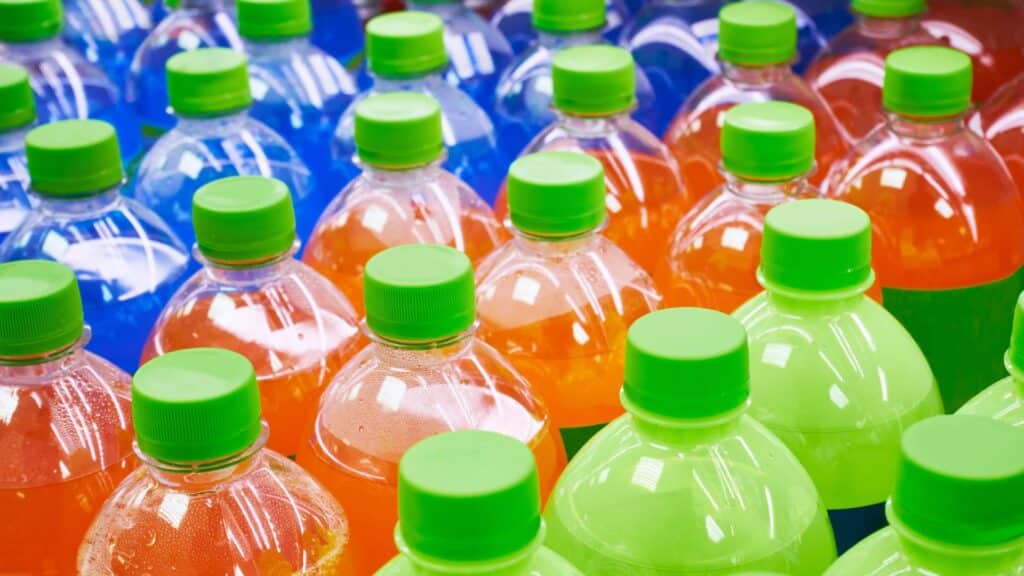
Preparing Formula with Distilled Water
When mixing baby formula with distilled water, it is important to follow the manufacturer’s instructions carefully. Here are some tips to keep in mind:
- Always use a clean bottle and sterile equipment when preparing the formula.
- Use distilled water that has been boiled and cooled to room temperature making formula.
- Add the recommended amount of powder formula to the water. Do not add extra minerals, additional fluoride or water as this can affect the concentration of nutrients.
- Stir the powdered formula gently to mix it well. Do not shake the bottle vigorously as this can cause bubbles and make it harder for your baby to drink.
- Check the temperature of the formula before feeding it to your baby. It should be lukewarm, not hot.
- Discard any leftover formula after feeding your baby. Do not reuse the formula as it can become contaminated with bacteria.
It is important to follow the manufacturer’s instructions when you plan to mix infant formula, as they have been designed to provide the correct balance of nutrients for your baby’s needs. Using too much or too little water can affect the concentration of nutrients and may not provide your baby with the nutrition they need to grow and develop.
The recommended ratio of water to baby formula may vary depending on the brand and type of powdered formula you are using. It is important to carefully read the instructions on the packaging and follow the recommended ratio. Typically, the ratio is one scoop of baby formula for every two ounces of water. However, always double-check with the specific instructions provided by the manufacturer of the baby formula.
In addition, the American Academy of Pediatrics recommends that parents should not use fluoride supplements when mixing infant formula with tap water, as this can increase the risk of dental fluorosis. Instead, parents should use low-fluoride bottled water or distilled water for formula preparation.
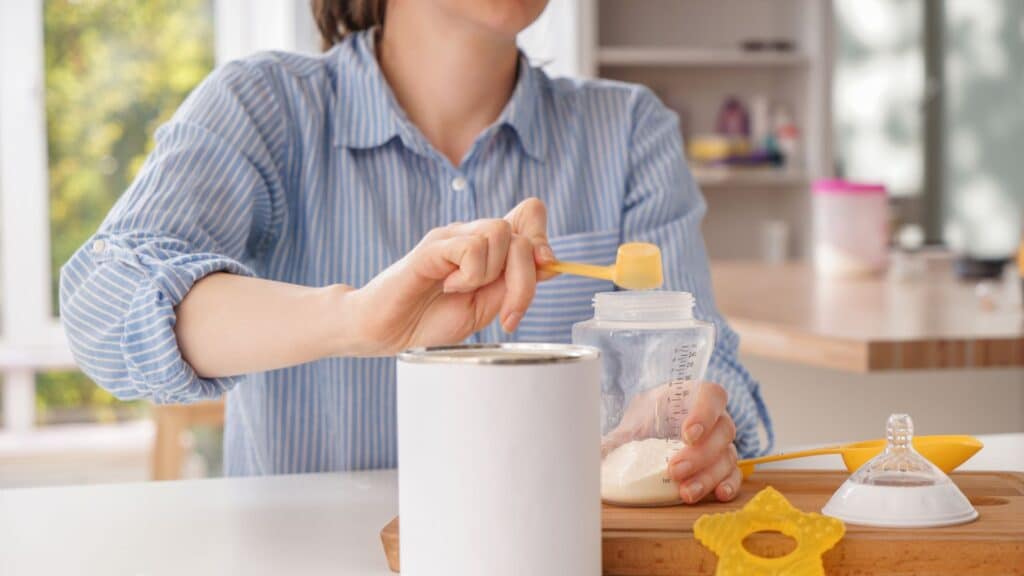
Consulting with Pediatricians and Health Professionals
When choosing water for your baby’s formula, it is essential to consult with pediatricians or other health professionals for personalized recommendations. These experts can provide guidance based on individual factors such as geographic location, water source quality, and any specific health concerns.
Geographic Location
The quality of water sources can vary greatly depending on your geographic location. Local water suppliers and regional regulations can impact the safety and quality of tap water. In some areas, tap water may contain higher levels of contaminants, such as lead, nitrates, or bacteria, that could pose a risk to your baby’s health. Pediatricians and health professionals can provide guidance on the water quality in your area and recommend appropriate water sources for your baby’s formula.
Water Source Quality
Water source quality is a crucial factor to consider when choosing water for your baby’s formula. Tap water, filtered water, and bottled water each have their pros and cons, as discussed in previous sections. Health professionals can help you evaluate the quality of your water sources and suggest the most suitable option for your baby based on the local water quality report and any specific concerns you may have.
For example, they may recommend boiling water before using it for formula preparation or suggest using distilled or purified water as a safer alternative. If you use liquid concentrate formula, health professionals may advise using purified bottled water to dilute the concentrate, ensuring that the water meets safety and quality standards.
Specific Health Concerns
Some babies may have specific health concerns or conditions that require special consideration when choosing water for their formula. For example, premature infants or babies with compromised immune systems may need additional precautions to ensure the safety of their formula water. In such cases, pediatricians and health professionals can provide tailored recommendations based on your baby’s unique needs.
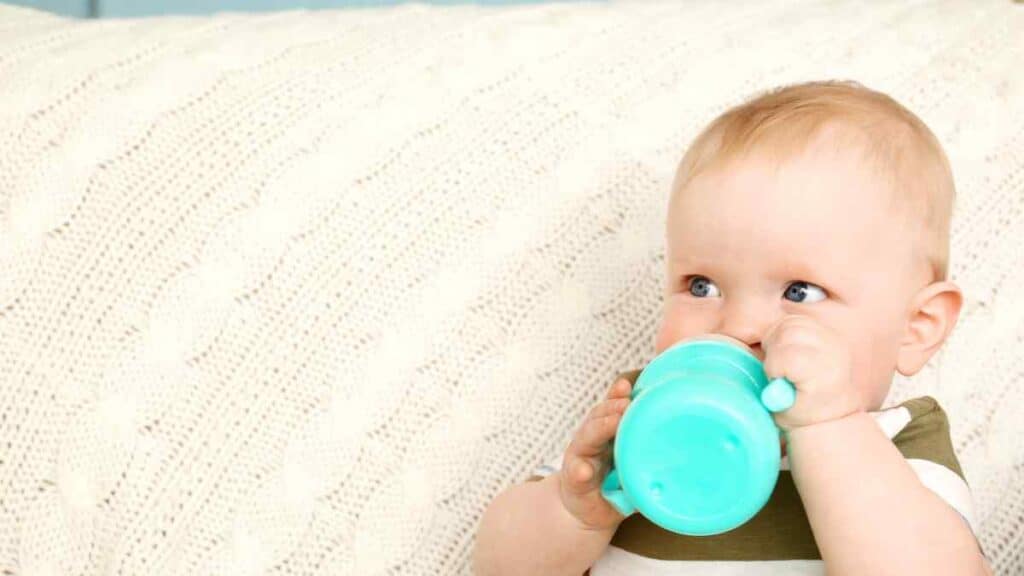
When Should You Give Your Baby Water?
Besides breast milk or formula, you may start giving your baby water after they reach six months, just as when you introduce solid foods as part of their diet. You can begin by offering them small amounts of cooled water as they slowly transition to solid foods. It’s also a technique that’s especially advisable for parents with children ages one-year-old and up.
However, it would help to remember that water should not replace breast milk or formula as this should still be their primary source of nutrition until they reach one year old. Although it may seem easier to give them water, their bodies have yet to adapt to it, causing them to experience nutrient loss and even water intoxication.
Many parents often use a sippy cup when teaching their younger babies to drink water. During this period, providing them with a sufficient amount of baby water can be helpful as your baby becomes more active. It’s also a highly advisable technique, significantly when raising breastfed babies.
Young Children Ages A Year Old
Once your child reaches 12 months old, it’s time to reduce breast milk intake gradually. You may start by slowly introducing them to the concept of breakfast, lunch, and dinner as part of their new routine. Additionally, it’s the perfect time for them to discover new foods other than breast milk or formula.
Ideally, kids should have at least 8 ounces of drinking water daily to stay hydrated while preventing water intoxication. You would then need to increase the amount each year as your child becomes more active. When babies drink water, it ensures they have proper bowel movements while replacing lost fluids.
Is Mineral Water Good for Your Baby?
As we’ve explored the various types of drinking water for babies, you may wonder if mineral water is the best choice for your little one. In this column, we will delve into the benefits of mineral water and how it compares to other options like tap water, spring water, and purified drinking water.
The Food and Drug Administration (FDA) regulates bottled water, ensuring it meets specific safety and quality standards. However, not all bottled water is created equal, and the mineral content can vary significantly between brands. This variation is essential to consider when choosing a bottled water brand for your baby.
One of the most significant benefits of mineral water is the presence of essential minerals, such as calcium and magnesium, which support your baby’s growth and development. Drinking spring water and mineral water can provide these essential minerals in addition to what your baby receives from their diet. Unlike purified drinking water, which undergoes processes like reverse osmosis and distillation to remove impurities, mineral water retains its natural mineral content.
Some mineral water brands even offer alkaline water, which has a higher pH than regular water. Advocates of alkaline water claim that it can neutralize acid in the body and provide potential health benefits. However, the scientific evidence supporting these claims is limited, and more research is needed to determine if alkaline water is beneficial for babies.
While mineral water has its advantages, there are some factors to consider when choosing the best water for your baby. One aspect is the total dissolved solids (TDS) level, which indicates the concentration of dissolved substances in the water. High TDS levels can indicate the presence of contaminants, so it’s essential to check the label and ensure the TDS level is suitable for your baby.
Another concern is the packaging. Some plastic bottles used by bottled water companies can contain chemicals that may leach into the water, especially when exposed to heat or sunlight. Opting for a reputable bottled water brand that uses safe and high-quality packaging materials can help mitigate this risk.
Lastly, it’s worth noting that municipal water supplies in many areas are safe and regulated, making tap water a viable and cost-effective option for older infants and toddlers. However, parents should consider boiling tap water or using a water filter for added safety, especially for younger babies.
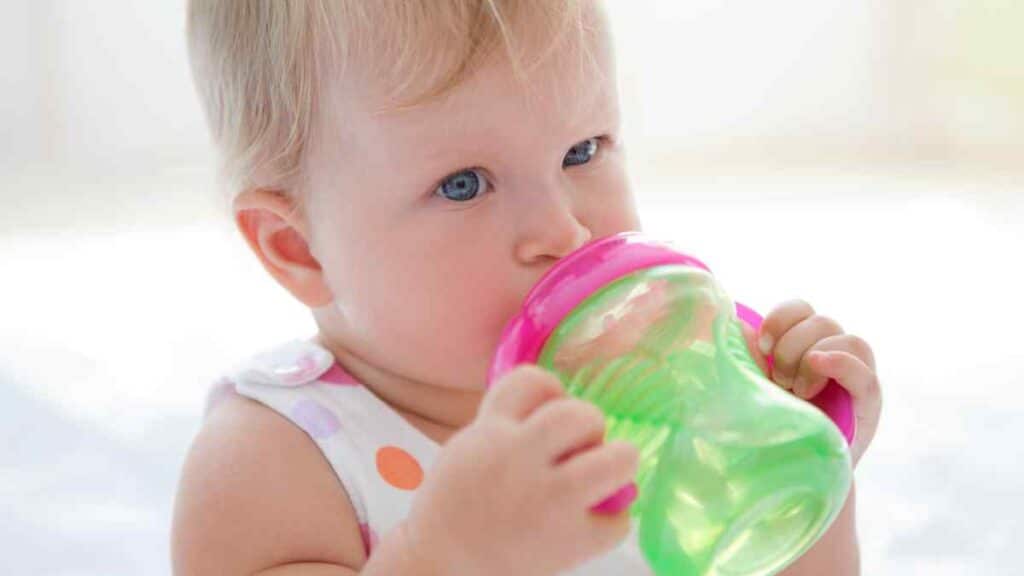
How to Keep Your Baby Hydrated
Typically, you must give your child access to drinking plain water to keep them hydrated. However, there are times when kids tend to act out, making it challenging to keep them adequately hydrated even with their favorite baby drinks. So, if you find encouraging your baby to drink water difficult, here are a few tips you can consider.
Frequent Sips are Advisable
Besides a dilute formula of cow’s milk, one effective way to let them stay hydrated is to offer small amounts of water throughout the day. You don’t need to ask them to drink 8 ounces of bottled water at once. Even a few sips from their sippy cup can already help. Meanwhile, if you want to try out diluted fruit juice, it’s highly advisable to limit their intake to 4 ounces daily, especially if you’re transitioning from breast milk or formula.
Capture Their Attention
Another way to encourage your child to drink baby water is by capturing their interest with creativity. You can make the entire process fun by introducing them to various shapes and colors. Consider using colorful straws or cups shaped like their favorite cartoon characters to get them excited.
Consider Their Activities
Children don’t have the same capability to regulate their body temperature as adults. So it’ll be much more challenging for them to cool off, especially when exposed to the hot weather or strenuous activities.
It’s essential to keep them hydrated before and after each activity. It’s best to encourage them to drink fluids during exercise. As a general rule, letting babies drink the water of 4 ounces every 20 minutes is a must. It’s a general rule to give them all the hydration without water intoxication.
Introduce Liquid Foods
Besides encouraging your child to eat solids, you can also start introducing your kids to water-rich foods after one year of age as you transition from breast milk or formula. It can be as simple as juices from undiluted fruit juice such as apples, grapes, oranges. You can also consider giving them flavor water or naturally sweetened drinks from lemon or cucumber! It’s an excellent choice if you want to let babies drink water independently.

Telltale Signs of Infant Dehydration
It’s only standard for a parent to get worried about their baby, especially if they notice signs of dehydration. So, here are a few symptoms of infant dehydration to serve as a guide. If you see any of these signs, it’s best to get in touch with your pediatrician.
- Fewer diaper changes compared to previous days/ lack of wet diapers
- Showing increased signs of exhaustion
- Sunken fontanelle, or the soft spot located on the infant’s head
- Dry mouth
- There aren’t any tears when the baby is crying
Understanding The Water Distillation Process
One common type of purified water that often surfaces in discussions is distilled water. Whether it’s for preparing baby formula, drinking, or even filling the iron, most parents prefer distilled water for its purity. This column aims to provide a comprehensive understanding of the water distillation process and its implications for our daily lives.
Implications for Drinking Water
One of the most common uses of distilled water is for drinking. Because it’s free from most impurities, many people prefer to use it in areas where municipal water supplies may not be reliable, or for those who prefer not to drink fluoridated water, common in many tap water supplies.
While small amounts of fluoride are beneficial for preventing cavities, particularly in permanent teeth, extreme cases can lead to fluorosis. Many experts often advise pregnant women, babies, and other vulnerable populations to limit their fluoride intake, and choosing distilled water can be one way to do that.
Role in Baby Formula Preparation
Many experts often recommend distilled water for preparing baby formula. Its high level of purity ensures that babies, who are particularly sensitive to contaminants, are given clean water.
However, it’s worth noting that distilled water lacks the extra minerals found in other types of water. While this isn’t an issue for adults, who get these minerals from solid food, it can be a point to consider for babies. The baby formula must provide these necessary minerals, given the role they play in a baby’s growth and development.
Other Uses of Distilled Water
Apart from drinking and baby formula preparation, distilled water is also ideal for use in certain household appliances like water softeners, steam irons, and humidifiers. The lack of minerals prevents build-up that can damage these devices over time.
Different Types of Bottled Water For Babies
In our previous column, we explored the benefits of mineral water for babies and discussed the importance of choosing the right type of water for your little one. As a natural progression, let’s delve into the various types of bottled water available and how they differ from one another. This column, titled “Different Types of Bottled Water for Babies,” will provide an overview to help you make an informed decision when selecting water for your baby.
Tap water
While tap water is readily available and regulated by municipal water supply systems, it may not always be the best option for young infants. Boiling tap water or using a home water filter can improve its safety, especially for babies under six months of age. As your baby grows, tap water can be a suitable and cost-effective choice as long as it meets safety standards.
Spring Water
Spring water flows naturally from an underground source and is bottled at the source. It contains various minerals that are beneficial to the human body. Spring water can be a good option for babies, as it retains its natural mineral content. However, always check the label for information on the source, treatment process, and the million total dissolved solids (TDS) to ensure the water’s safety and suitability for your baby.
Distilled Water
Distilled water is produced by boiling water and collecting steam, which leaves behind impurities. This process results in water with a higher boiling point and a lower mineral content. While distilled water is safe for babies, it lacks the essential minerals found in spring and mineral water, making it a less ideal choice as a regular source of drinking water for your little one.
Reverse Osmosis Water
Reverse osmosis (RO) water undergoes a purification process that removes contaminants by forcing water through a semipermeable membrane. While RO water is often referred to as “filtered water,” it’s important to note that this process also removes many beneficial minerals. As a result, RO water might not be the best choice for babies as their primary drinking water source.
Sparkling Water
Sparkling water is carbonated, either naturally or artificially, by dissolving carbon dioxide into the water under pressure. Due to its carbonation, sparkling water can cause gas and discomfort in babies, making it an unsuitable choice for their consumption.

How Should Bottled Mineral Water Be Stored?
As we have discussed the different types of bottled drinking water for babies, it’s equally important to consider the correct storage of bottled water. Proper storage can maintain the quality and safety of the water, ensuring your little one receives the health benefits from its essential minerals. Let’s discuss a comprehensive guide broken down into several sub-sections.
Understanding the Importance of Proper Storage
Bottled water, including spring water and mineral water, is regulated by the Food and Drug Administration (FDA) to ensure its safety and quality for human consumption. However, even with these regulations, the way you store bottled water can affect its safety and taste. Poor storage conditions can potentially lead to the leaching of chemicals from plastic bottles into the water, which could impact your baby’s health.
Choosing the Right Storage Location
Many bottled water companies recommend storing their products in a cool, dry place away from chemicals, solvents, and strong odors. Heat and sunlight can degrade the plastic over time, potentially releasing harmful substances into the water. Therefore, avoid storing bottled water in places like a garage or a car trunk, particularly during the summer months.
Refrigerating Bottled Water
While it’s not necessary to refrigerate unopened bottled water, once opened, it’s best to keep it chilled to slow down the growth of any potential bacteria. However, be sure to consume it within a few days after opening for the best quality and safety.
Use of Reusable Water Bottles
If you’re transferring water from a purchased bottle to a smaller, reusable water bottle for convenience, ensure the reusable bottle is made of a safe material and is cleaned regularly. Plastic bottles marked with recycling codes 1, 2, 4, and 5 are generally considered safe for reuse. Always wash and thoroughly dry reusable water bottles between uses to prevent bacterial growth.
Transitioning to Home Water Purification Systems
For those considering a shift from bottled water to tap water, consider using a home water purification system to ensure the water’s safety. Systems such as reverse osmosis and water filters can effectively remove contaminants while preserving other minerals beneficial to the human body. Always follow the manufacturer’s instructions for maintaining and replacing these systems to ensure optimal performance and safety.
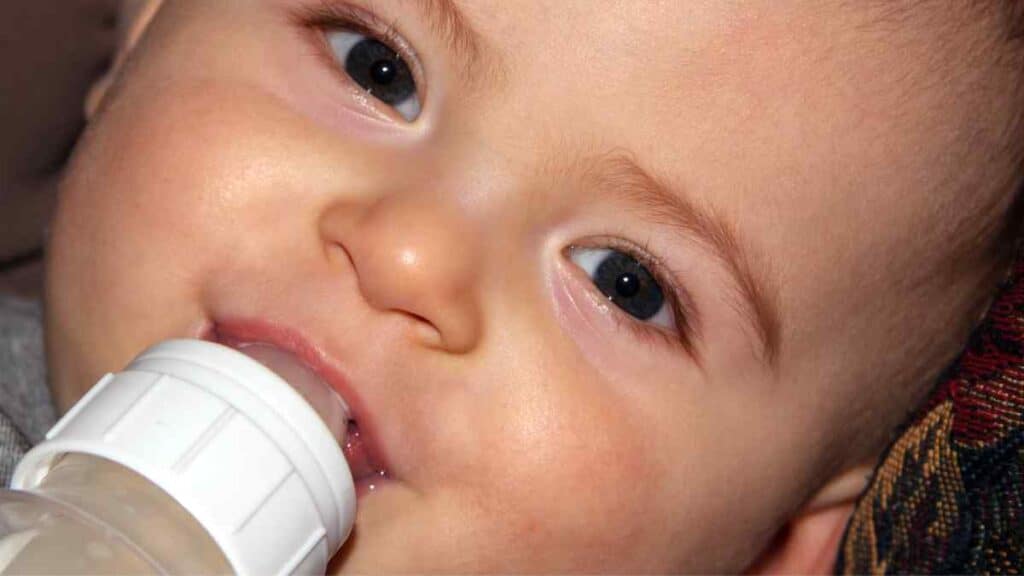
What is the Healthiest Water To Drink For Your Baby?
As we delve into the proper storage of bottled mineral water to maintain its quality and safety, let’s turn our attention to the crucial question: What is the healthiest water to drink for your baby? With numerous options available in the market, from spring waters to artesian water, this question is more relevant than ever for parents.
Understanding Water Types
When it comes to drinking water, different types come with varying mineral content and potential health benefits. Bottled waters often undergo a filtration process to remove any impurities, and some brands even have their own bottling plant to ensure the water’s safety and quality. However, not all bottled waters are created equal.
Spring and Artesian Water
Spring waters flow naturally from a spring and usually contain beneficial minerals. Artesian water, on the other hand, comes from a well that taps into a confined underground aquifer. Both types of water can be excellent choices for your baby due to their natural mineral content. However, always check the labels for any additional treatments or processes these waters may have undergone before reaching the bottle.
Filtered Tap Water
While normal water directly from your tap may not always be the best option for young infants, it can be made safer and healthier through the use of water filters. These filters effectively remove chlorine, lead, and other contaminants, providing you with clean and safe drinking water for your baby. Plus, it’s a more environmentally-friendly choice compared to single-use plastic bottles.
Mineral Water
Mineral water, as we’ve discussed in our previous columns, contains essential minerals like calcium and magnesium that are beneficial for your baby’s growth and development. The mineral content, however, can vary significantly between brands, so it’s essential to check the labels.
Determining the Healthiest Water for Your Baby
So, what’s the healthiest water for your baby? The answer largely depends on your baby’s age and specific nutritional needs, the water quality in your area, and your personal preferences. Purified or boiled tap water is usually recommended for younger infants, especially those under six months. Spring water, artesian water, or mineral water can be healthy choices for older babies and toddlers due to their natural mineral content.
Conclusion
In conclusion, undertaking the important task of introducing water to a baby’s diet, specifically while using distilled water for formula preparation, can seem like an uphill task, especially for first-time parents. Nevertheless, adherence to the appropriate guidelines can ensure optimum health and growth for your child. Begin with a gradual introduction of water, maintaining suitable temperature, and offering it between feedings using a sippy cup or a small, clean feeding bottle. Extra precautions should include avoiding the use of sweetened or flavored water and adhering strictly to the manufacturer’s instructions when preparing your baby’s formula with distilled water.
Consider that each baby is unique and will adapt at their pace. Keeping a vigilant eye on their overall well-being and not hesitating to seek professional medical advice when in doubt is crucial. Remember, fostering healthy habits at this early stage paves the foundation for their health in the future. Feel free to share your queries or experiences in the comments section. It takes a village to raise a child; let us be part of your journey into parenthood.
We’d love to hear from you! Have a question? Let us know in the comments.



